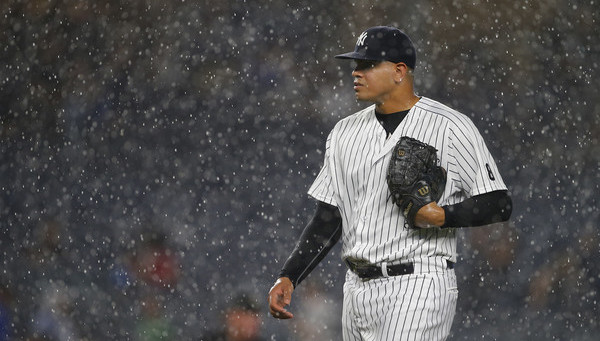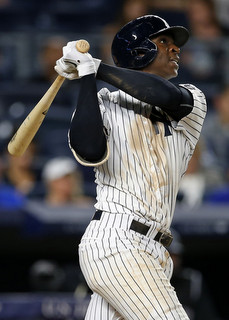
With the 2016 season now complete, we can begin to look forward to the offseason and the 2017 Yankees, and this winter a lot of attention will be paid to arbitration-eligible players. The Yankees have a lot of them. Nine, in fact. Some of them are pretty important parts of the team too.
Yesterday Matt Swartz at MLB Trade Rumors published his annual arbitration salary projections for next season. Swartz’s model is pretty darn accurate and it gets more and more precise with each passing season. The numbers might not be exact, but they’re usually in the ballpark. Here’s what Swartz’s model projects for the Yankees’ nine arbitration-eligible players.
- Michael Pineda (5.099) – $7.8MM
- Dustin Ackley (5.087) – $3.2MM
- Nathan Eovaldi (5.013) – $7.5MM
- Adam Warren (4.031) – $2.3MM
- Didi Gregorius (3.159) – $5.1MM
- Dellin Betances (3.078) – $3.4MM
- Austin Romine (3.045) – $900K
- Aaron Hicks (3.041) – $1.4MM
- Tommy Layne (2.142) – $1.2MM
That’s $32.8M worth of arbitration salaries next year, which works out to a $14.6M raise over what those nine players earned this past season. As a reminder, players need three years of service time (3.000) to qualify for arbitration in most cases. Some, like Gregorius and Layne, are arbitration-eligible four times as a Super Two. The Super Two cutout this year is approximately 2.127, according to Steve Adams. That doesn’t really affect the Yankees. Anyway, here are some thoughts on the projected arbitration salaries.
1. The Betances projection seems light. The arbitration process is pretty archaic. Old school stats like ERA and saves — especially saves — matter most. Betances has been a setup man for the majority of his career, so he doesn’t have those big money making saves totals, which is going to hurt his arbitration case. We all know Dellin has been one of the two or three best relievers in baseball since Opening Day 2014 though.
Swartz’s model has trouble with elite players with unprecedented resumes. Tim Lincecum damn near broke the thing when he went into arbitration with two Cy Youngs a few years ago. Betances leads all relievers in innings and strikeouts over the last three seasons by a lot. He struck out 392 batters from 2014-16. Next most by a reliever? Andrew Miller with 326. Yeah. Look at the five highest strikeout totals by a reliever the last three years:
- 2014 Betances: 135
- 2015 Betances: 131
- 2016 Betances: 126
- 2016 Miller: 123
- 2015 Aroldis Chapman: 115
Yeah. Betances is also a three-time All-Star. Do you know how many other relievers have been to the All-Star Game each of the last three years? None. Not one. Dellin’s the only one. The All-Star Game selections plus the bulk inning and strikeout totals mean Betances is going into arbitration with far more earning potential than most setup men. He could break Swartz’s model, so to speak.
As best I can tell, the record salary for a first year arbitration-eligible reliever is $6.25M by Jonathan Papelbon back in the day. The lack of saves will probably prevent Betances from breaking Papelbon’s record, though I do think he’s going to wind up with a salary closer to Papelbon’s than the projected salary above. Dellin isn’t a normal reliever and projecting his arbitration salary with a one size fits all model probably won’t work.
2. Eovaldi and Ackley are goners. Swartz’s model projects no raise for Ackley. He made $3.2M this year and the model has him making $3.2M next year. That’s what happens when you barely play and barely hit before suffering a season-ending injury. Given the salary and the lack of production, Ackley is a prime non-tender candidate this offseason. The Yankees might release him after the World Series to clear 40-man roster space rather than wait until the December 2nd tender deadline.
As for Eovaldi, the model projects a $1.9M raise, though that’s pretty irrelevant. He recently underwent major elbow surgery, including his second Tommy John surgery, so he’s going to miss the entire 2017 season. There’s no sense in paying Eovaldi that much money to not pitch next season, especially when he’ll be a free agent next winter. The business side of baseball can be cruel. Eovaldi is hurt and soon he’s going to be unemployed too. The Yankees will non-tender him. Brian Cashman all but confirmed it.
A non-tender wouldn’t necessarily mean Eovaldi’s career in pinstripes is over. The Yankees could re-sign him to a smaller contract with an eye on 2018. They’ve done that before, sign injured pitchers to a two-year deal and rehab them in year one. Think Jon Lieber and Andrew Bailey and David Aardsma. The second Tommy John surgery is much riskier than the first, but with pitching so in demand, it’s probably worth exploring a two-year deal with Eovaldi. Just not at the projected salary.

3. Extension time for Gregorius? Gregorius made $2.425M this past season and projects to make $5.1M next season, which is a $2.675M raise. His salary projects to more than double. Didi will be in his second of four arbitration years as a Super Two next year, so if we apply similar raises going forward, we get $7.775M in 2017 and $10.45M in 2018. That’s a real quick and dirty way of estimating his earning potential the next three years.
That rough estimate puts Gregorius at $23.325M from 2016-18 before he hits free agency. Is it worth it to explore a long-term extension this offseason? It is if you think his power breakout this past season was real, and there are reasons to believe it is. Gregorius is only 26, remember. He’s entering what should be the best years of his career. A four-year deal that guarantees him $35M or so seems worthwhile for the Yankees. We’re talking about a prime age player at a premium position.
At the same time, the Yankees have a ton of shortstops in the minors, namely Tyler Wade in Double-A plus both Gleyber Torres and Jorge Mateo in High-A. I wouldn’t worry about that though. Gregorius is a talented young player at a hard to fill position and those guys are worth locking up. If there’s a logjam at shortstop when Wade and Torres and Mateo and whoever are ready, great! That’s a good problem.
4. Big Mike’s big salary. Being a starting pitcher is pretty good when arbitration time arrives. Even mediocre starters like Pineda get hefty raises. He made $4.3M this past season and projects for $7.8M next year, so we’re talking about a $3.5M raise. That’s despite a 6-12 record and a 4.82 ERA (90 ERA+) in 175.2 innings. That stuff matters in arbitration.
Pineda’s raise has more to do with his 207 strikeouts and AL leading 10.6 K/9. And really, $7.8M is still below market value for a pitcher of Pineda’s caliber. Guys like him will run you $10M to $12M or so in free agency. Probably more these days. It would be worth asking Pineda and his representatives what it would take to get an extension done this offseason, simply because the upcoming free agent pitching classes are so weak.
5. The remain projections are fair. The projections for Warren ($2.3M), Hicks ($1.4M), Layne ($1.2M), and Romine ($900,000) seem just about right. Not high enough to consider a non-tender and not low enough to see it as a bargain. That could change in a year, but right now, they’re fair. Weirdly enough, it wouldn’t surprise me if all four of those guys are on the 2017 Opening Day roster and it wouldn’t surprise me if all four are jettisoned in the offseason. I feel like we’re in for some surprises this winter.
Leave a Reply
You must be logged in to post a comment.